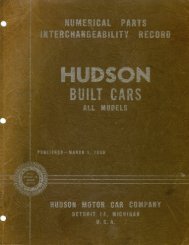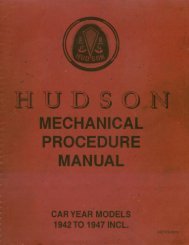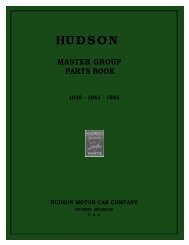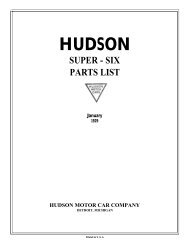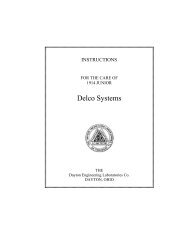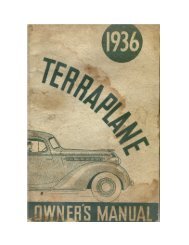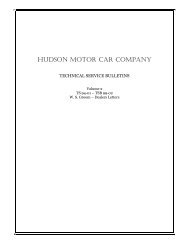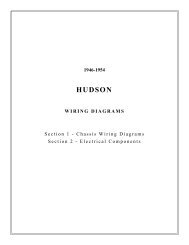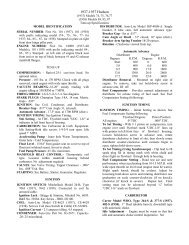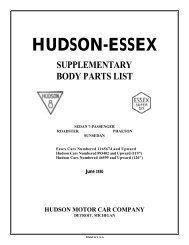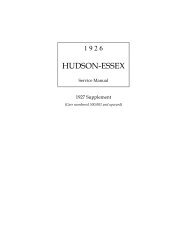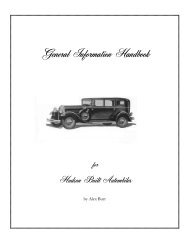1948-1952 Shop Service Manual - - Hudson-Essex-Terraplane Club
1948-1952 Shop Service Manual - - Hudson-Essex-Terraplane Club
1948-1952 Shop Service Manual - - Hudson-Essex-Terraplane Club
Create successful ePaper yourself
Turn your PDF publications into a flip-book with our unique Google optimized e-Paper software.
3 - 14 ENGINE<br />
5. Oil the shim freely with light engine oil and Install the<br />
bearing and bearing cap to the block with the shim<br />
equally spaced on the bearing. Tighten to 75 foot lbs.<br />
6. Rotate the crankshaft one-half turn by hand; if the<br />
crankshaft drags or if the crankshaft cannot be turned by<br />
hand with a .002" shim in place, but turns freely without<br />
the .002" shim it indicates that the clearance is more than<br />
.0015" and that the standard size bearing can be used. If,<br />
however, the crankshaft turns freely without any drag, it<br />
indicates that the bearing which has the .002" shim stock<br />
is too loose.<br />
7. If bearing is too loose in paragraph 6, remove the .002"<br />
shim and insert a .003" shim as a checking gauge; now if<br />
bearing drags when crankshaft is turned by hand a .001"<br />
undersize bearing can be used.<br />
NOTE: The same procedure can be used for checking .002" ,<br />
.010" or .012" undersize bearings keeping in mind that the<br />
.0005" to .0015" clearance must be maintained.<br />
Main bearings for the 6 cylinder engines are furnished in<br />
standard size and .001", .002", .010" and .012" undersizes.<br />
Bearing upper and lower halves are interchangeable.<br />
However bearing No. 1 is not interchangeable with No. 2, 3<br />
or 4. Bearing shells are stamped with the part number or<br />
size. Bearings should be replaced in pairs; never use a new<br />
bearing half with an old bearing half.<br />
CAUTION: No. 2 and No. 3 bearing caps can be reversed<br />
in error. Always place punch marks on the caps and the<br />
block before removal to insure proper Installation.<br />
1. After the proper bearing sizes have been selected, start the<br />
upper shells in place, and with KMO-734 Bearing Shell<br />
Remover and Replacer Tool entered in oil hole of crankshaft<br />
and with hinged head of Replacer against bearing<br />
end, rotate crankshaft, pulling the bearing into position,<br />
Figure 14.<br />
NOTE: The bearing shells are held in position by a raised<br />
tongue in the bearing shell which fits into a machined groove<br />
in the bearing cap. When Installing the upper shells, the end<br />
opposite the notched end should be entered first. When<br />
Installing<br />
Installing the bearing cap, the end with the machined<br />
groove should be on the same side and next to the corresponding<br />
groove in the cylinder block.<br />
MAIN BEARING, CRANKSHAFT,<br />
AND CAP BORE DIAMETERS<br />
BEAR-<br />
ING<br />
SIZE<br />
Standard<br />
.001 U.S.<br />
.002 U.S.<br />
.010 U.S.<br />
.012 U.S.<br />
SHELL<br />
THICK-<br />
NESS<br />
.0955<br />
.0952<br />
.0960<br />
.0957<br />
.0965<br />
.0962<br />
.1005<br />
.1002<br />
.1015<br />
.1012<br />
(6 CYLINDER)<br />
CRANK-<br />
SHAFT<br />
DIAMETER<br />
2.4998<br />
2.4988<br />
2.4998<br />
2.4988<br />
2.4978<br />
2.4973<br />
2.4898<br />
2.4893<br />
2.4878<br />
2.4873<br />
CAP<br />
BORE<br />
DIAMETER<br />
2.692<br />
2.691<br />
2.692<br />
2.691<br />
2.692<br />
2.691<br />
2.692<br />
2.691<br />
2.692<br />
2.691<br />
REAR MAIN BEARING CAP<br />
Installation:<br />
Check the rear bearing cap oil seal and if replacement of<br />
the seal is necessary, proceed as follows:<br />
1. Crowd the seal material into the outer groove of the bearing cap<br />
by hand and with Main Bearing Oil Seal Installer J-2779, drive<br />
the seal tightly into the groove by tapping handle of tool with a<br />
bronze hammer, Figure 16.<br />
NOTE: Large diameter of the tool cylinder should be to the front of<br />
cap with the lesser dimension compressing the seal at rear of cap.<br />
2. After the seal has been properly seated in the bearing cap and in<br />
the block, and while the tool is still compressing the seal, cut the<br />
seal off flush with the top face of the cap. Make a good clean<br />
straight cut so that no f r ay e d ends will be clamped between<br />
upper and lower caps. DO NOT CUT SEAL TOO SHORT.<br />
The seal must entirely fill the groove; otherwise an oil leak will<br />
occur.



